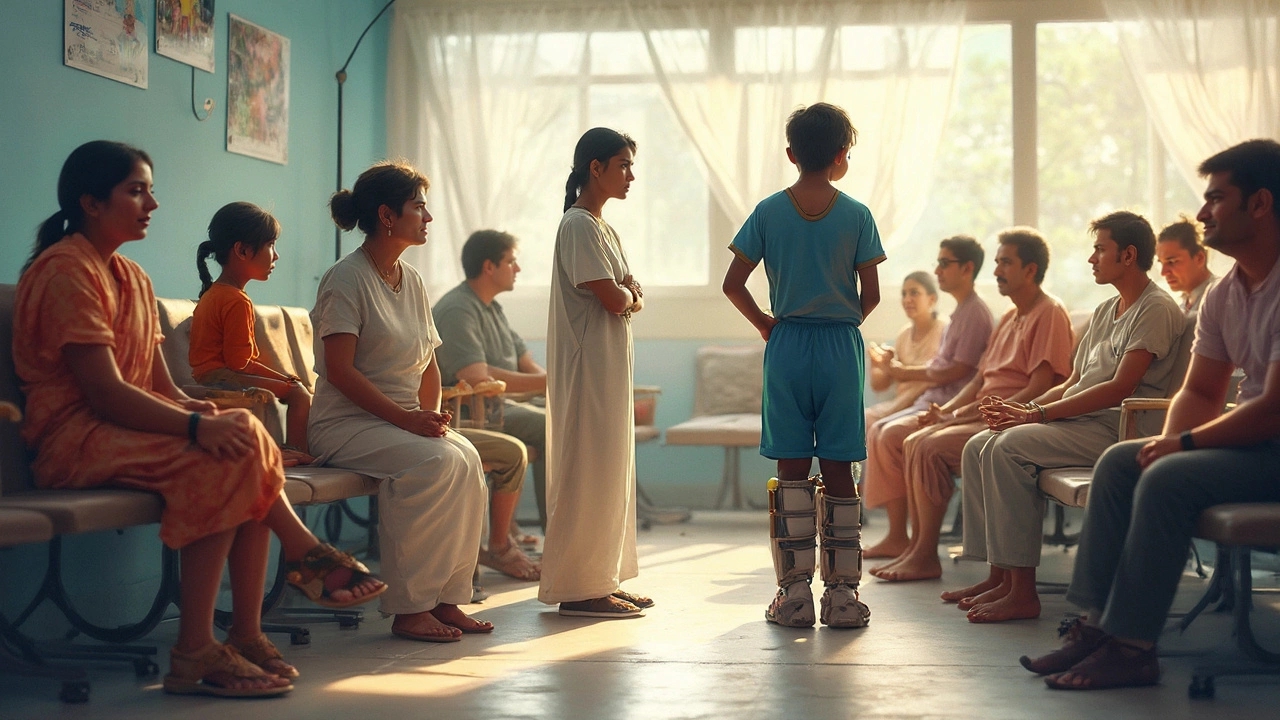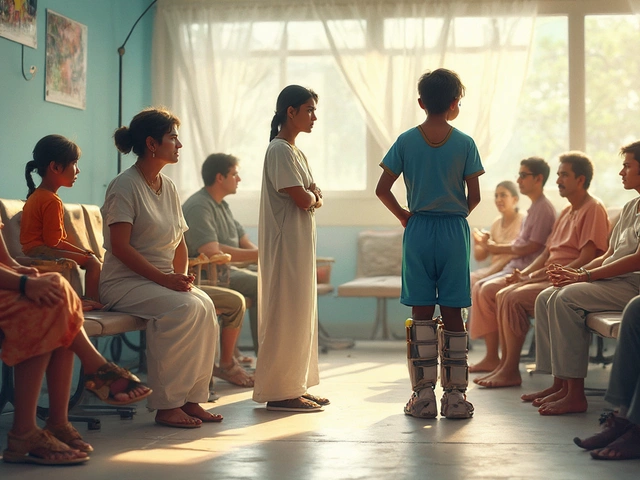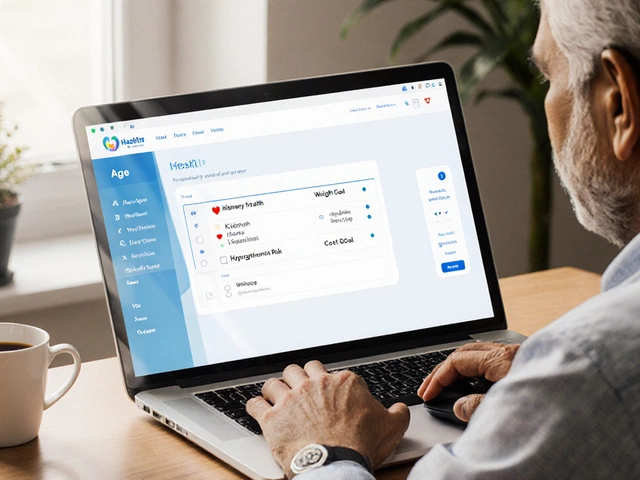Ever had a nagging knee ache, a weird shoulder pop, or back pain that keeps you up at night? Most folks shrug it off or try a home remedy, but sometimes, your regular doc says, 'You need to see an orthopedic specialist.' Sounds intense, right? Turns out, it’s pretty common. Over 50 million people in India alone visit orthopedic hospitals every year for everything from fractures to old sports injuries.
So why do doctors hand out these referrals? Basically, orthopedics is all about your bones, joints, ligaments, muscles, and tendons—the scaffolding that keeps you upright and moving. If stuff hurts, feels weak, or just isn’t working right, you might end up at their door. The best part? Seeing an orthopedic specialist can save you from living with pain, missing work, or letting a small problem turn into something bigger than it has to be.
If your pain won’t go away after rest, you’re limping, or your joint is suddenly swollen, don’t just “wait and watch.” These are all red flags, and an orthopedic doctor knows where to look and how to fix what’s broken—often without surgery. Stick around to find out the most common reasons people get referred, what happens inside an orthopedic hospital, and how you can make recovery a little less of a headache.
- Common Reasons for Orthopedic Referrals
- What Happens at an Orthopedic Hospital?
- Top Signs You Shouldn’t Ignore
- What to Expect at Your First Visit
- Tips for a Smooth Recovery
- When To Get a Second Opinion
Common Reasons for Orthopedic Referrals
Doctors don’t send you to an ortho hospital just for fun. Usually, there are clear warning signs or lingering problems that your regular doctor can’t fully solve. Here’s a breakdown of the top reasons why people get referred:
- Joint pain that won’t quit, even with rest and basic treatment. Think knees, shoulders, hips, or ankles after an injury or just from years of wear and tear.
- Bone injuries including fractures that don’t line up straight or heal well—or if a bone breaks more than once in the same spot.
- Back and neck pain that goes on for weeks and starts to mess with your daily routine. Back pain is actually one of the top reasons adults miss work worldwide.
- Sports injuries, whether you’re a pro athlete or someone who went too hard in a weekend cricket match. Common ones are ligament tears (like ACL), meniscus problems, and torn rotator cuffs.
- Limping, numbness, or tingling in your arms or legs, which could signal nerve or disc issues.
- Swelling or stiffness in the joints, especially if you’re waking up sore every morning or struggling to move after sitting still.
- Deformities you weren’t born with. For example, a finger bending oddly after a fall or a bump that seems to be getting bigger over time.
Check out this quick table—these are the most common issues that land people in an orthopedic referral:
| Condition | Typical Symptom | % of Ortho Referrals |
|---|---|---|
| Osteoarthritis | Pain, stiffness, reduced movement in joints | 38% |
| Fractures | Severe pain, swelling, deformity | 22% |
| Back and Neck Pain | Constant ache, nerve pain, reduced mobility | 18% |
| Sports Injuries | Instability, sharp pain, popping sounds | 12% |
| Others (Tendon, Nerve, Congenital) | Swelling, weakness, numbness | 10% |
If you see yourself in any of these groups, you’re not alone. The key is catching the problem early. Ignoring symptoms can lead to long-term damage or even make you dependent on painkillers. Getting checked by the right specialist gives you a better shot at real recovery.
What Happens at an Orthopedic Hospital?
Stepping into an orthopedic hospital can seem a bit much at first, but the process is pretty straightforward. They’re all about getting to the root of your pain or injury and getting you moving again as soon as possible. Here’s what you can usually expect.
First up, you’ll fill out some paperwork about your health history and recent problems. Then, you’ll usually meet an orthopedic specialist who’ll want details. They’ll ask about when the pain started, how it feels, and what makes it worse or better. Don’t hold back—more info helps them help you.
Physical exams come next. The doc might check your range of motion, press on sore spots, or have you walk around to see how your body’s working (or not working). It’s not just poking and prodding—they use simple tests to see exactly where the trouble is.
Diagnostics are a big deal at an orthopedic hospital. If something looks off, you might be sent for X-rays, MRIs, or CT scans, usually right in the same building. Here’s a quick look at how often each test comes up for patients with joint pain:
| Test Type | Frequency (%) |
|---|---|
| X-ray | 80 |
| MRI | 30 |
| CT Scan | 10 |
After your results come in, the doctor explains what’s going on. This is where the real plan starts. Depending on your issue, you might need:
- Physical therapy sessions—tailored exercises to help you heal up
- Medications—like painkillers or anti-inflammatories
- Splints, braces, or casts—to keep stuff in place while it heals
- Shots—like steroid injections, if it’s something swollen or inflamed
- Surgery—only if there’s no real fix with the simple stuff
Not every appointment is about surgery. In fact, less than 15% of all ortho hospital visits end up in the operating room. Most folks get better with non-surgical treatments and a bit of patience. The main goal is getting you back to daily life without constant pain.
One tip: always bring records of previous injuries or treatments. It helps the doc figure out what’s new and what’s an old battle scar. And never be shy about asking questions—you have the right to understand your body and treatment options.
If you hear the words orthopedic referral, don’t panic. The hospital’s setup to cover everything—diagnosis, treatment, recovery—all under one roof, which means less running around and faster answers for you.
Top Signs You Shouldn’t Ignore
It’s tempting to push through discomfort, especially when you’re busy, but some symptoms wave a big red flag. Ignoring them could mean risking permanent damage or a way longer recovery. So, how do you know when to stop toughing it out and actually get help?
- Joint pain that sticks around: Pain that lasts more than a week, especially after a minor injury, is a classic reason for an orthopedic referral. Swelling or tenderness that won’t quit falls into the same group.
- Swelling that gets worse or won’t go down: If your knee, ankle, or wrist blows up and ice doesn’t do much, get it checked. This can mean anything from a torn ligament to a bone infection.
- Pain at rest or at night: If your pain wakes you up, or you’re hurting even when lying down, it’s not something you should ignore. Bone tumors, arthritis, or nerve problems sometimes start this way.
- Visible deformity or new lumps: A finger pointing the wrong direction, a joint that looks weird, or any lumps that spring up can’t wait for a "let’s see if it goes away" approach. Dislocations and tumors need fast attention.
- Loss of movement or strength: Struggling to grip, walk, or lift is serious. If you suddenly can’t move a joint or it feels floppy, get help immediately.
Doctors see injuries every day, but a study published in the Indian Journal of Orthopaedics found that about 30% of people who delay seeing a specialist for joint pain end up with worse, long-term issues.
"Ignoring ongoing pain or changes in joint shape is the biggest mistake we see—early diagnosis by an orthopedic specialist prevents years of discomfort." — Dr. Sunil Kamath, Consultant Orthopedic Surgeon, Mumbai
Here’s a quick look at how often these signs actually lead to orthopedic referrals, based on hospital records from 2024:
| Symptom | % Referred to Orthopedics |
|---|---|
| Persistent Joint Pain (>7 days) | 62% |
| Swelling Not Improved After Home Care | 47% |
| Loss of Mobility/Strength | 35% |
| Visible Deformity | 78% |
If any of these remind you of your own aches or injuries, don’t brush them off. Early help really can mean an easier fix—and getting back to your old self faster.

What to Expect at Your First Visit
Walking into an orthopedic hospital for the first time can feel a bit unnerving, but honestly, it's all pretty straightforward. Here’s what usually happens so you’re not caught off guard.
First off, you’ll fill out some paperwork. They'll ask about your medical history, past injuries, and any medications you're on. The more accurate you are here, the better the care you’ll get.
Once you’re called in, the orthopedic doctor (often called an ortho or bone doc) will chat with you about your problem. They’ll want to know things like:
- How long you’ve had your pain or problem
- If you had a recent injury, fall, or accident
- What makes it better or worse
- How the issue affects your day-to-day life
Next comes a physical exam. This could mean moving your arm, leg, or back in different ways. Sometimes, they use special tools to check strength, flexibility, or how far you can move a joint. Don’t worry—if something hurts, tell them! They're not trying to torture you.
Very often, you'll be sent for imaging right away or after the exam. The most common tests are:
- X-ray (for bones and joint alignment)
- MRI (for soft tissue like ligaments and muscles)
- CT scan (for a detailed bone picture)
Here’s a quick glimpse at how common these tests are at a typical orthopedic hospital:
| Test | Used For | How Often Ordered (%) |
|---|---|---|
| X-ray | Broken bones, arthritis, abnormal joints | 75% |
| MRI | Torn ligaments, cartilage, muscle tears | 22% |
| CT Scan | Complex fractures, tumors | 3% |
Sometimes, they’ll recommend blood tests if infection or inflammation is a concern.
After all this, the doctor usually explains what’s going on and suggests some next steps. It might be rest, meds, physical therapy, or rarely, planning a surgery. If you’re lucky, you walk out with a simple fix. Sometimes you’ll need to come back for a follow-up after the tests are reviewed.
A couple of tips: Wear comfy clothes—there’s a good chance you’ll be moving around. Bring any old reports or scans if you have them. Don’t be scared to ask questions and write down what the doctor says, especially if medical talk sounds confusing.
Tips for a Smooth Recovery
Getting care from an orthopedic referral is only half the battle—you’ve got to help your body bounce back. Recovery isn’t just about lying in bed. Your daily choices play a huge part in healing well and getting your strength back faster.
The best results come when you follow some simple, proven rules. Studies say people who stick to their rehab plan can cut their recovery time by almost 30%. Not bad, right? Here’s what works in real life:
- Don’t skip physical therapy: Sure, it can feel like a hassle, but PT is the best way to get your mobility back fast. Your therapist will show you how to do safe movements so you don’t injure yourself again.
- Move, but don’t overdo it: Gentle walking or basic stretching can help blood flow and stop your body from getting stiff. But ignore those ‘no pain, no gain’ gym memes. Listen to your body.
- Keep up with meds as prescribed: You don’t need to tough out the pain. If your ortho doc says take your meds, take them on time. Let the hospital team know if you have side effects.
- Follow wound care instructions: If you have stitches, splints, or casts, keep them dry and clean. Infections are a big reason why folks end up back in the hospital.
- Fuel up with good food: Your body needs protein, vitamins, and minerals to heal bones and muscles. Easy hack—add a boiled egg, curd, or sprouts to your daily diet.
If you’re wondering when you’ll feel 100%, check out typical recovery times below. Remember, everyone heals at their own pace but sticking to your plan keeps you on track.
| Condition/Injury | Average Recovery Time |
|---|---|
| Simple fracture | 6–8 weeks |
| Minor ligament tear | 2–4 months |
| Knee or hip replacement | 3–6 months |
| Muscle strain | 2–6 weeks |
If something feels off—a sudden fever, worsening pain, or weird swelling around your injury—call your ortho hospital right away. Fast action can stop bigger problems before they start.
When To Get a Second Opinion
Ever feel like your diagnosis is missing something, or your treatment plan just doesn’t sit right with you? You’re absolutely allowed to question it. In fact, one out of every three patients in India seeks a second opinion for major bone or joint treatments. That’s not being stubborn—it’s just smart healthcare.
So, when should you ask another orthopedic referral or specialist what they think? Here are some clear signs:
- You’ve been told you need surgery and want to be sure there’s no simpler fix.
- Your pain or symptoms aren’t getting better, even after weeks of treatment or physio.
- You just got a serious diagnosis like arthritis, a complex fracture, or bone cancer.
- You’re not fully clear about your diagnosis or treatment plan, or you feel rushed into a decision.
- The recommended treatment seems risky, experimental, or much more aggressive than you expected.
Many people worry that asking for a second opinion will hurt their doctor’s feelings or hold up their care. But in reality, 78% of orthopedic specialists say they welcome patients double-checking big decisions, especially for complicated surgeries and long-term treatments. It’s all about making sure you find a plan that fits your needs and feels right to you.
Let’s break it down with a quick look at popular reasons people seek second opinions in ortho hospitals last year:
| Reason for Second Opinion | Percentage (%) |
|---|---|
| Recommended major surgery | 47% |
| Persistent pain with no answer | 21% |
| Confusion about diagnosis | 18% |
| Lack of progress after therapy | 9% |
| Other reasons (cost, doubts, etc.) | 5% |
Tip: When you go for that second opinion, bring all your medical records, scan reports, and notes from previous visits. The more info the new doctor has, the better advice you’ll get. Don’t rush the process. Sometimes the best way to heal is to ask more questions and get really comfortable with your final plan.







